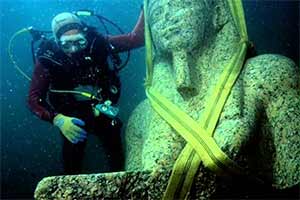Sunken cities: Egypt’s lost worlds – An extraordinary example of integration of cultures
Prof. Francesco Carelli , University Milan, Rome
The British Museum has run (May – November 2016) a major exhibition on two lost Egyptian cities, the Egyptian harbours and their recent rediscovery by archaeologists beneath the Mediterranean Sea bed.
 It shows how the exploration of Thonis-Heracleion (both in Egyptian and Greek denomination) and Canopus – submerged at the mouth of the River Nile for over a thousand years (around 750 A.C) – is really and strongly transforming our understanding of the relationship between ancient Egypt and the Greek world and the great importance of these ancient cities for all the commercial trade in antique Egypt.
It shows how the exploration of Thonis-Heracleion (both in Egyptian and Greek denomination) and Canopus – submerged at the mouth of the River Nile for over a thousand years (around 750 A.C) – is really and strongly transforming our understanding of the relationship between ancient Egypt and the Greek world and the great importance of these ancient cities for all the commercial trade in antique Egypt.
300 outstanding objects are exposed together for the exhibition including more than 200 spectacular finds excavated off the coast of Egypt near Alexandria between 1996 and 2012. Important loans from Egyptian museums rarely seen before outside Egypt (and the first such loans since the Egyptian revolution) are supplemented with objects from various sites across the Delta drawn from the British Museum’s collection; most notably from Naukratis – a sister harbour town to Thonis- Heracleion and the first Greek settlement in Egypt.
Likely founded during the 7th century BC, Thonis-Heracleion and Canopus were busy, cosmopolitan cities that once sat on adjacent islands at the edge of the fertile lands of the Egyptian Delta, intersected by canals. After Alexander, the Great’s conquest of Egypt in 332BC, centuries of Greek (Ptolemaic) rule followed. The exhibition reveals how cross-cultural exchange and religion flourished, particularly the worship of the Egyptian god of the afterlife, Osiris.
By the 8th century AD, the sea had reclaimed the cities and they lay hidden several meters beneath the seabed, their location and condition unclear. Although well-known from Egyptian decrees and Greek mythology and historians, past attempts to locate them were either fruitless or very partial. The exhibition shows how a pioneering European team led by Franck Goddio, in collaboration with the Egyptian Ministry of Antiquities, made use of the most up-to-date technologies to find them. Thanks to the underwater setting, a vast number of objects of extraordinary archaeological significance have been astonishingly well preserved.
Pristine monumental statues, fine metal ware and gold jewelry reveal how Greece and Egypt interacted in the late first millennium BC. These artifacts offer a new insight into the quality and unique character of the art of this period and show how the Greek kings and queens who ruled Egypt for 300 years adopted and adapted Egyptian beliefs and rituals to legitimise their reign. A strong example of integration.
The exhibition features a number of extraordinary, monumental sculptures. A 5.4m granite statue of Hapy, a divine personification of the Nile’s flood, greets visitors as they enter the space. Masterpieces from Egyptian museums such as the Apis bull from the Serapeum in Alexandria are shown alongside magnificent recent finds from the sea. One such piece is the stunning sculpture from Canopus representing Arsinoe II (the eldest daughter of Ptolemy I, founder of the Ptolemaic dynasty). The Greco-Macedonian queen became a goddess beloved to both Egyptians and Greeks after her death and is depicted here as the perfect embodiment of Aphrodite, a goddess of beauty ‘who grants fortunate sailing’.
The exhibition also covers the arrival of Greeks in Egypt, when they were hosts and not rulers; privileged but controlled by the pharaohs. A complete stela from Thonis-Heracleion advertises a 380 BC royal decree of the Egyptian pharaoh Nectanebo I. It states that 10% of the taxes collected on all goods imported from the ‘Sea of the Greeks’ into Thonis-Heracleion and on all trade operations at Naukratis were to be donated to an Egyptian temple.
A wide range of objects, from modest to grand and costly, bears witness to the piety of both inhabitants and visitors at these major religious centres. Lead models of barges uncovered in the sacred waterway linking Thonis-Heracleion to Canopus are unique and moving finds. They are associated with the Mysteries of Osiris, the most popular festival celebrated annually across Egypt during the month of Khoiak (mid-October to mid- November). Ranging in size from 6 to 67cm, these reproduce in metal a flotilla of 34 papyrus barges that would have been displayed on a waterway to celebrate the first sacred navigation of the festival. According to religious texts, each barge was to bear the figure of an Egyptian god, and would have been illuminated by 365 lamps. The lead barges are lasting testimonies possibly left by people who, long ago, celebrated this festival in the Canopic region.
Only a tiny proportion of these sites have revealed their secrets. The on-going underwater archaeological mission continues to bring to light new masterpieces and further research every year as the most recent finds from 2012 are showing.
People sometimes assume that when two cultures mix, the essence of each is diluted and, as a result, weakened; this exhibition demonstrates the opposite. It is a rare opportunity to reveal the beauty and strength of Late Pharaonic art and culture, alongside the latest research on the momentous intermingling between Egyptian and Greek communities in Egypt at that time. It shows ancient Egypt not as an isolated civilisation, but as an outward looking, influential and inclusive society.

